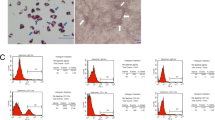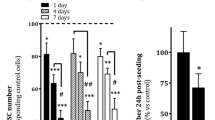Abstract
Background:
The liver is an organ with remarkable regenerative capacity; however, once chronic fibrosis occurs, liver failure follows, with high mortality and morbidity rates. Continuous exposure to proinflammatory stimuli exaggerates the pathological process of liver failure; therefore, immune modulation is a potential strategy to treat liver fibrosis. Mesenchymal stem cells (MSCs) with tissue regenerative and immunomodulatory potential may support the development of therapeutics for liver fibrosis.
Methods:
Here, we induced hepatic injury in mice by injecting carbon tetrachloride (CCl4) and investigated the therapeutic potential of conditioned medium from tonsil-derived MSCs (T-MSC CM). In parallel, we used recombinant human IL-1Ra, which, as we have previously shown, is secreted exclusively from T-MSCs and resolves the fibrogenic activation of myoblasts. Hepatic inflammation and fibrosis were determined by histological analyses using H&E and Picro-Sirius Red staining.
Results:
The results demonstrated that T-MSC CM treatment significantly reduced inflammation as well as fibrosis in the CCl4-injured mouse liver. IL-1Ra injection showed effects similar to T-MSC CM treatment, suggesting that T-MSC CM may exert anti-inflammatory and anti-fibrotic effects via the endogenous production of IL-1Ra. The expression of genes involved in fibrosis was evaluated, and the results showed significant induction of alpha-1 type I collagen, transforming growth factor beta, and tissue inhibitor of metalloproteases 1 upon CCl4 injection, whereas treatment with T-MSC CM or IL-1Ra downregulated their expression.
Conclusions:
Taken together, these data support the therapeutic potential of T-MSC CM and/or IL-1Ra for the alleviation of liver fibrosis, as well as in treating diseases involving organ fibrosis.





Similar content being viewed by others
References
Kim SY, Kim YR, Park WJ, Kim HS, Jung SC, Woo SY, et al. Characterisation of insulin-producing cells differentiated from tonsil derived mesenchymal stem cells. Differentiation. 2015;90:27–39.
Cho KA, Park M, Kim YH, Woo SY, Ryu KH. RNA sequencing reveals a transcriptomic portrait of human mesenchymal stem cells from bone marrow, adipose tissue, and palatine tonsils. Sci Rep. 2017;7:17114.
Cho KA, Park M, Kim YH, Woo SY, Ryu KH. Conditioned media from human palatine tonsil mesenchymal stem cells regulates the interaction between myotubes and fibroblasts by IL-1Ra activity. J Cell Mol Med. 2017;21:130–41.
Kim JY, Park M, Kim YH, Ryu KH, Lee KH, Cho KA, et al. Tonsil-derived mesenchymal stem cells (T-MSCs) prevent Th17-mediated autoimmune response via regulation of the programmed death-1/programmed death ligand-1 (PD-1/PD-L1) pathway. J Tissue Eng Regen Med. 2018;12:e1022–33.
Cho KA, Park M, Kim YH, Ryu KH, Woo SY. Mesenchymal stem cells inhibit RANK-RANKL interactions between osteoclasts and Th17 cells via osteoprotegerin activity. Oncotarget. 2017;8:83419–31.
Park M, Kim YH, Woo SY, Lee HJ, Yu Y, Kim HS, et al. Tonsil-derived mesenchymal stem cells ameliorate CCl4-induced liver fibrosis in mice via autophagy activation. Sci Rep. 2015;5:8616.
Massagué J. TGFβ signalling in context. Nat Rev Mol Cell Biol. 2012;13:616–30.
Tan Q, Hu J, Yu X, Guan W, Lu H, Yu Y, et al. The role of IL-1 family members and kupffer cells in liver regeneration. Biomed Res Int. 2016;2016:6495793.
Herrera Abreu MT, Wang Q, Vachon E, Suzuki T, Chow CW, Wang Y, et al. Tyrosine phosphatase SHP-2 regulates IL-1 signaling in fibroblasts through focal adhesions. J Cell Physiol. 2006;207:132–43.
Gieling RG, Wallace K, Han YP. Interleukin-1 participates in the progression from liver injury to fibrosis. Am J Physiol Gastrointest Liver Physiol. 2009;296:G1324–31.
Sung MS, Lee EG, Jeon HS, Chae HJ, Park SJ, Lee YC, et al. Quercetin inhibits IL-1beta-induced proliferation and production of MMPs, COX-2, and PGE2 by rheumatoid synovial fibroblast. Inflammation. 2012;35:1585–94.
Graves DT, Cochran D. The contribution of interleukin-1 and tumor necrosis factor to periodontal tissue destruction. J Periodontol. 2003;74:391–401.
Borthwick LA. The IL-1 cytokine family and its role in inflammation and fibrosis in the lung. Semin Immunopathol. 2016;38:517–34.
Siegmund B, Lear-Kaul KC, Faggioni R, Fantuzzi G. Leptin deficiency, not obesity, protects mice from Con A-induced hepatitis. Eur J Immunol. 2002;32:552–60.
Yoshiji H, Kuriyama S, Miyamoto Y, Thorgeirsson UP, Gomez DE, Kawata M, et al. Tissue inhibitor of metalloproteinases-1 promotes liver fibrosis development in a transgenic mouse model. Hepatology. 2000;32:1248–54.
Zhao DC, Lei JX, Chen R, Yu WH, Zhang XM, Li SN, et al. Bone marrow-derived mesenchymal stem cells protect against experimental liver fibrosis in rats. World J Gastroenterol. 2005;11:3431–40.
Jung KH, Shin HP, Lee S, Lim YJ, Hwang SH, Han H, et al. Effect of human umbilical cord blood-derived mesenchymal stem cells in a cirrhotic rat model. Liver Int. 2009;29:898–909.
Zhang D, Jiang M, Miao D. Transplanted human amniotic membrane-derived mesenchymal stem cells ameliorate carbon tetrachloride-induced liver cirrhosis in mouse. PLoS One. 2011;6:e16789.
Mutsaers HA, Olinga P. Editorial: organ fibrosis: triggers, pathways, and cellular plasticity. Front Med (Lausanne). 2016;3:55.
Mirkovic S, Seymour AM, Fenning A, Strachan A, Margolin SB, Taylor SM, et al. Attenuation of cardiac fibrosis by pirfenidone and amiloride in DOCA-salt hypertensive rats. Br J Pharmacol. 2002;135:961–8.
Di Sario A, Bendia E, Macarri G, Candelaresi C, Taffetani S, Marzioni M, et al. The anti-fibrotic effect of pirfenidone in rat liver fibrosis is mediated by downregulation of procollagen alpha1(I), TIMP-1 and MMP-2. Dig Liver Dis. 2004;36:744–51.
Takakuta K, Fujimori A, Chikanishi T, Tanokura A, Iwatsuki Y, Yamamoto M, et al. Renoprotective properties of pirfenidone in subtotally nephrectomized rats. Eur J Pharmacol. 2010;629:118–24.
Usunier B, Benderitter M, Tamarat R, Chapel A. Management of fibrosis: the mesenchymal stromal cells breakthrough. Stem Cells Int. 2014;2014:340257.
Maria AT, Toupet K, Bony C, Pirot N, Vozenin MC, Petit B, et al. Antifibrotic, antioxidant, and immunomodulatory effects of mesenchymal stem cells in HOCl-induced systemic sclerosis. Arthritis Rheumatol. 2016;68:1013–25.
Acknowledgements
This work was supported by the National Research Foundation (NRF) of Korea, funded by the Ministry of Science and ICT (2017R1E1A1A01073021) and Intramural Research Promotion Grants from Ewha Womans University School of Medicine.
Author information
Authors and Affiliations
Corresponding author
Ethics declarations
Conflicts of interest
The authors declare no actual or potential conflict of interest.
Ethical statement
All experimental procedures and protocols were approved by the Animal Ethics Committee at Ewha Womans University College of Medicine (Seoul, Korea; No. ESM 18-0405), and experiments were performed in accordance with relevant guidelines and regulations.
Rights and permissions
About this article
Cite this article
Kim, YH., Cho, KA., Park, M. et al. Conditioned Medium from Tonsil-Derived Mesenchymal Stem Cells Relieves CCl4-Induced Liver Fibrosis in Mice. Tissue Eng Regen Med 16, 51–58 (2019). https://doi.org/10.1007/s13770-018-0160-8
Received:
Revised:
Accepted:
Published:
Issue Date:
DOI: https://doi.org/10.1007/s13770-018-0160-8




